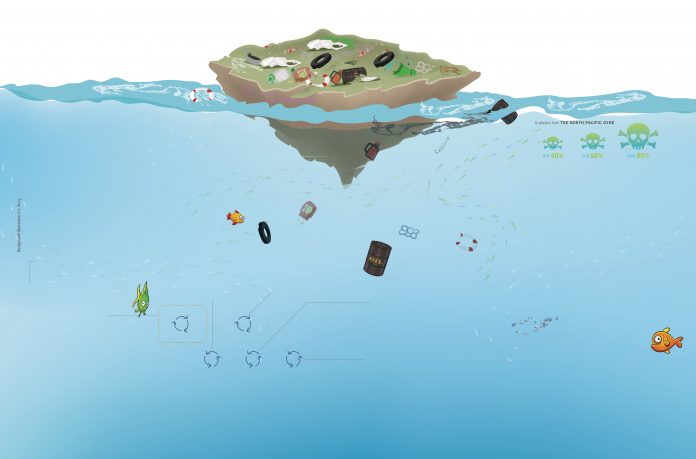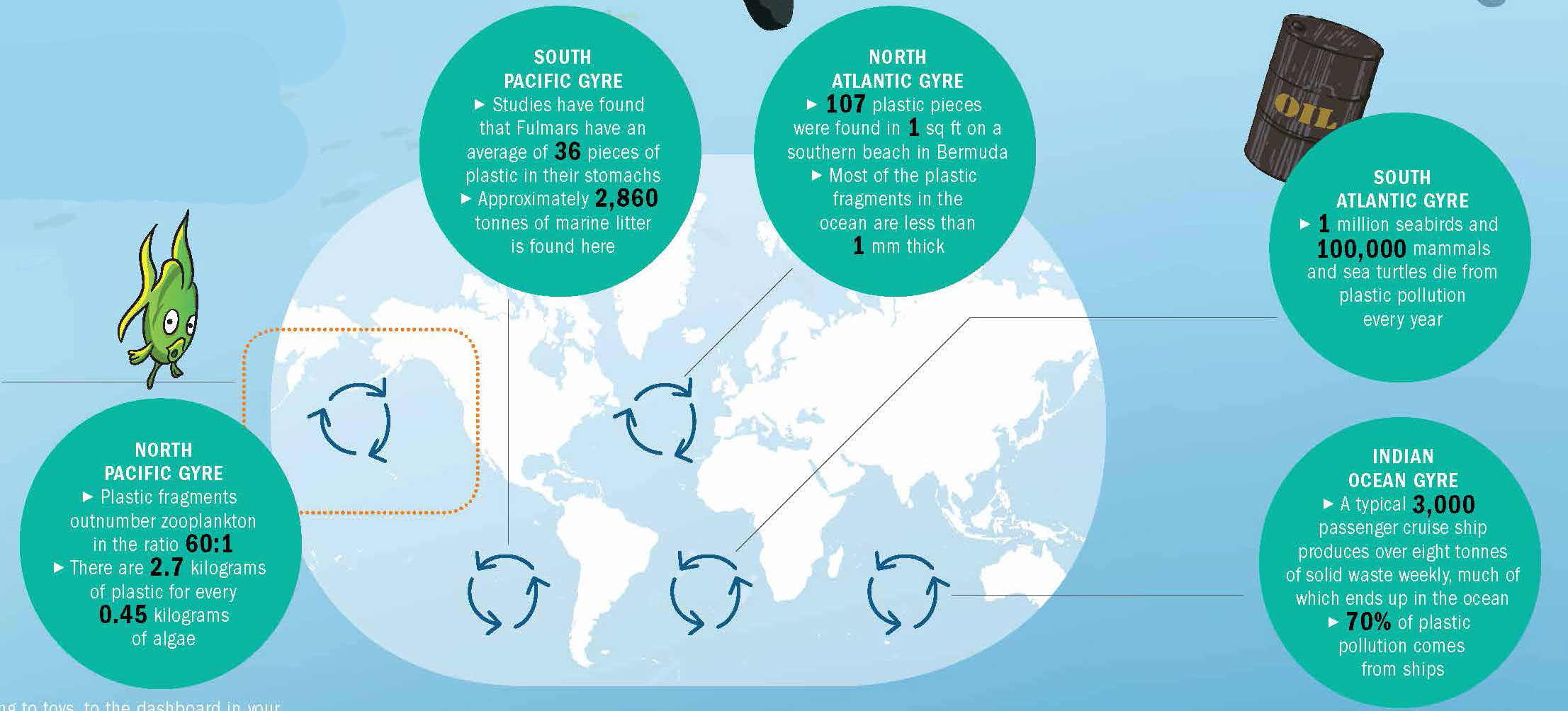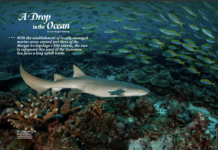By now, most of us are aware that there is a large patch of plastic floating in the middle of the Pacific Ocean. What many of us may not know is that it’s not made up of plastic bags and empty bottles. It’s made up of billions of tiny pieces of plastic and it’s basically invisible unless you’re floating in it. While this might sound better, it’s actually much worse for the environment – and for you.
FORMATION
Of the 90 million tonnes of plastic people use each year, about 10%, ends up in the ocean. 70% of that eventually sinks, but the other 30% is carried on the surface by ocean currents. When the plastic ends up in the waters of the Pacific, much of it is swept up into currents that lead to the Pacific Gyre. Garbage from the east coast of Asia takes roughly a year to reach it; garbage from the west coast of North America takes five years.
THE FIVE GYRES
Although not widely discussed, there are in fact five main gyres in the world’s oceans and several smaller gyres throughout Alaska and Antarctica. The most commonly discussed gyre is the North pacific Gyre, known as the Great Pacific Garbage Patch due to the mass of marine debris that has collected there.

Currents carry the plastic everywhere. Rubber ducks lost from a shipping container in the North Pacific were found near Scotland, in the North Atlantic. Tsunami debris from Japan arrived in North America, after crossing the largest ocean on Earth in just 10 months.
SIZE
The borders of the plastic garbage patch are difficult to determine because much plastic is in pieces too small to be seen by satellites or planes. Estimates of the size range from about 650,000 square kilometres (an area roughly the size of Texas) to 15.5 million square kilometres, which would mean that the garbage patch covers about 10 percent of the entire Pacific Ocean.
PLASTIC IS MADE OF TOXINS
331 million barrels of petroleum and natural gas liquids were used to make US plastic products, equal to about 5% of the national petroleum consumption.
Plastics contain toxic chemicals:
PHTHALATES
[/ultimate_heading][ultimate_heading]
FLAME-RETARDANTS
[/ultimate_heading][ultimate_heading]
BISPHENOL-A
[/ultimate_heading]
More toxins adhere as plastic breaks down

40% contained PESTICIDES like DDT. 50% contained PCBs (BANNED by US Congress in 1979 for having various NEUROTOXIC EFFECTS). 80% contained PAHs (may be HIGHLY CARCINOGENIC)
PLASTIC CHEMICALS
Plastics in the water absorb floating chemicals, which are attracted to the plastics’ oil base. Many of these chemicals are known as persistent organic pollutants, which may never leave the environment or break down. These chemicals include: ALDRIN (insecticide) • CHLORDANE (pesticide) •DIELDRIN (insecticide) • DDT (pesticide) • DIOXINS (toxic chemicals that are an industrial waste product of actions like metal smelting and paper bleaching) • ENDRIN (insecticide) • FURANS (toxic chemicals used as solvents) • HEPTACHLOR (insecticide) • HEXACHLOROBENZENE (fungicide) • Polychlorinated Biphenyls (or PCBs, coolant and lubricant) • TOXAPHENE (insecticide)
PHOTODEGRADATION
The sun breaks down plastic into smaller and smaller pieces, but can never break it down entirely. Unlike organic materials, which eventually biodegrade, the plastic breaks into ever-smaller pieces, while still remaining a polymer. As it breaks apart, the plastic ultimately becomes small enough to be ingested by aquatic organisms, which reside near the ocean’s surface.
Plastic waste enters the food chain.
IMPACT OF PLASTIC POLLUTION ON MARINE LIFE
- >80% of the rubbish found on coasts around the world on International Clean-up Day is single-use plastic
-
54% of the 120 marine mammal species on the threatened list have been observed entangled in or ingesting plastic
-
73.9 million pounds of plastic are spread throughout the world’s gyres
-
92.5% of dead seabirds (northern Fulmars) in a study had ingested plastic in amounts equal to 5% of their body weight
-
Chemicals used in plastics have been found in fish, molluscs, sea mammals and other sea life, which in turn is consumed by us
-
Microplastic concentrations in the North Pacific Gyre increased 100 times in the past four years
WHAT CAN WE DO TO HELP?
- USE LESS PLASTIC
- Instead of plastic bags, use reusable bags
- Say no to straws
- Use your own utensils instead of single-use ones
- To-go cups. Go with reusable mugs and cups
- Repair or upgrade your electronics. Recycle the old item when you need something new
- Buy items with minimal packaging
- Buy clothing with natural materials; synthetic fibres pollute the ocean
Read the rest of this article in No. 97 Issue 4/2013 of Asian Geographic magazine by subscribing here or check out all of our publications here.












